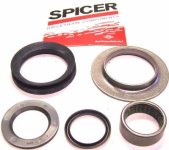tacobronco
Jr. Member
- Joined
- Nov 15, 2011
- Messages
- 97
How far do you guys drive the spindle bearings (National B-2110) into the spindles?
The reason I ask is that I found out the hard way that if you only drive them in far enough for the little inner seal to sit on top of them, then when you install the axleshaft spacer ring and outer seal, there is not enough room for the outer seal to flex enough to actually fit around the seal surface on the axleshaft when you try to install the axleshaft. On the other hand, if you drive the bearing all the way in to the step inside the spindle bore, then the seal fits fine, but the bearing rollers ride awfully close to the edge of the machined area on the axleshaft where they are intended to ride. Obviously there is a happy medium, but I can't find it spec'd anywhere. Randy Lyman in his "Differentials" book just says to drive the bearing in far enough for the inner seal to sit on top of the bearing - which is what I thought I did, and it did not work. I believe driving the bearing in a little as possible is better for the strength/stability of the axleshaft.
(BTW, I have the style of axleshaft/spindle that uses a traditional 2-lip seal pressed into the inboard side of the spindle, not the funky "J-seal" that uses that weird accordion-looking seal slid over the axleshaft.)
The reason I ask is that I found out the hard way that if you only drive them in far enough for the little inner seal to sit on top of them, then when you install the axleshaft spacer ring and outer seal, there is not enough room for the outer seal to flex enough to actually fit around the seal surface on the axleshaft when you try to install the axleshaft. On the other hand, if you drive the bearing all the way in to the step inside the spindle bore, then the seal fits fine, but the bearing rollers ride awfully close to the edge of the machined area on the axleshaft where they are intended to ride. Obviously there is a happy medium, but I can't find it spec'd anywhere. Randy Lyman in his "Differentials" book just says to drive the bearing in far enough for the inner seal to sit on top of the bearing - which is what I thought I did, and it did not work. I believe driving the bearing in a little as possible is better for the strength/stability of the axleshaft.
(BTW, I have the style of axleshaft/spindle that uses a traditional 2-lip seal pressed into the inboard side of the spindle, not the funky "J-seal" that uses that weird accordion-looking seal slid over the axleshaft.)












